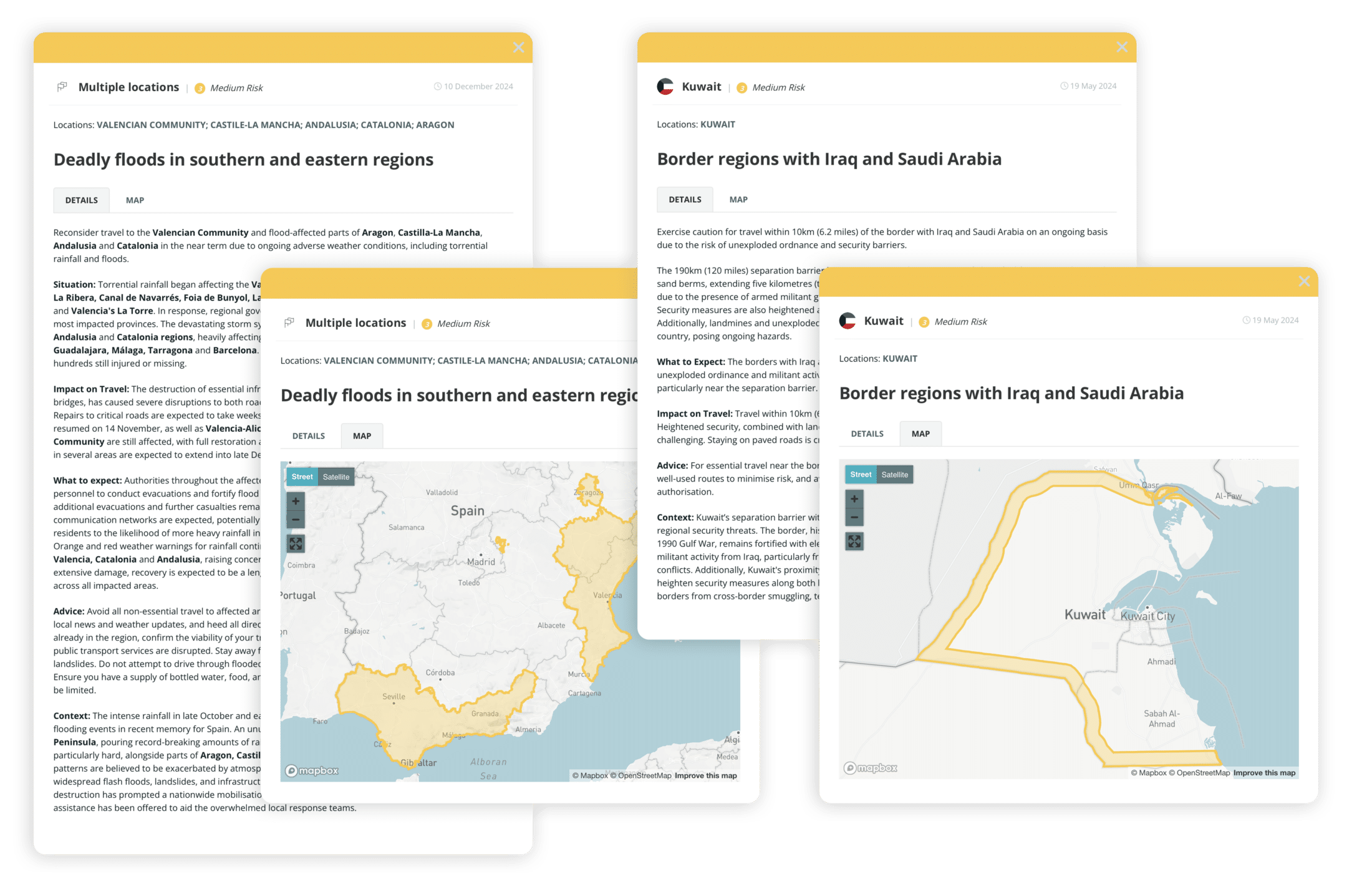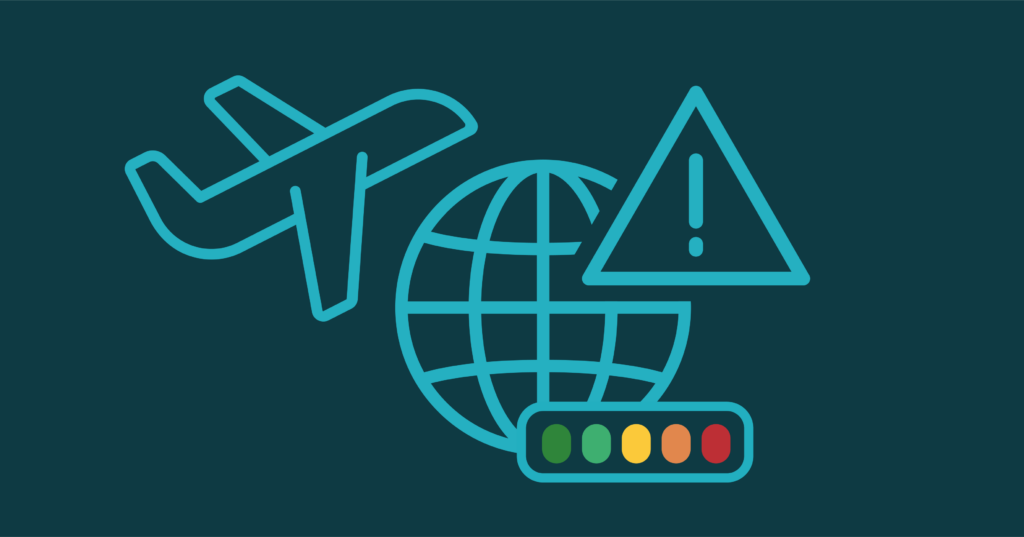With contributions by Adam Schrader, Claudia Gualdi, Marco Túlio Lara and Nikita Billier
Travel advisories are essential tools for keeping travellers informed and safe, offering critical insights into potential risks at their destinations. While governments and private organisations both issue these advisories, their methods, priorities and perspectives can differ significantly. This article explores the differences between government-issued and Riskline Travel Advisories, focusing on the type of information provided, regional nuances, update frequencies and potential biases.
Key information in government travel advisories
Typically, government-issued advisories provide travellers with a range of practical information. They often cover:
- Entry/exit requirements: Visa policies and necessary documentation
- Safety and security: Crime, terrorism and civil unrest information
- Local laws and cultural expectations: Guidance to help travellers navigate local customs and legal requirements
- Health risks: Guidance on vaccinations and disease prevention
- Travel within the country: Information about transportation and road safety
- Natural hazards: Warnings about possible natural risks like floods or hurricanes
- Consular contacts: Emergency contacts for embassies and consulates
A closer look at Riskline Advisories
Riskline Advisories are concise reports of 400–500 words designed to analyse political, security and travel-related events that may impact travel safety, plans or assets. Sitting between Alerts and more detailed Country/City reports, they focus on events lasting days to weeks, offering timely and practical advice tailored to travellers’ needs.

Riskline Advisories are divided into two main types:
Geographic: Covering specific areas with unique security conditions
Thematic: Addressing risks that span multiple regions but share a common theme
These categories mirror Alert subcategories, such as Politics, Conflict, Terrorism, Crime, Unrest, Natural and Health, ensuring all relevant risks are comprehensively covered.
Each Riskline Advisory is structured into key sections:
Situation: A summary of what has happened
What to expect: A look at the immediate conditions travellers may encounter
Impact on travel: How the situation affects transportation, infrastructure and services
Advice: Clear, actionable recommendations for travellers
Context: Broader background to help understand the bigger picture
Understanding travel advisories: Key differences
While government advisories focus on their own citizens, Riskline offers guidance applicable to all travellers, regardless of nationality.
Although both cover similar topics, Riskline Advisories stand out by offering deeper insights into regional nuances and timely intelligence. They add significant value for corporate travellers by delivering hyper-local information and region-specific alerts that directly impact safety, ultimately enhancing the overall travel experience.
Risk levels and classifications
To better understand how travel advisories evaluate safety, let’s compare their risk level systems. Governments often employ a four-tier classification system to categorise risks:
- Level 1: Exercise normal precautions
- Level 2: Exercise increased caution
- Level 3: Reconsider travel
- Level 4: Do not travel
This simple structure is helpful for a broad audience but can sometimes lack specificity regarding the nature or source of the risk.
Riskline uses a detailed five-tier risk scale to inform travellers about the severity of potential disruptions and dangers.
- Level 1: Low
- Level 2: Moderate
- Level 3: Medium
- Level 4: High
- Level 5: Extreme
Riskline enhances its risk scale with additional categories and detailed descriptions, providing tailored advice and insights for different travel types and risk levels.
The update gap between Riskline and government advisories
The “last updated” date in government advisories indicates when the information was last reviewed, which is important for assessing its relevance as situations can change quickly.
Riskline ensures that advisories are frequently updated, providing travellers with the latest, most accurate information. This is especially valuable for those heading to less-known destinations, where broader government advisories may overlook regional risks.
Riskline Advisories are typically produced within one to two hours of incidents with ongoing impacts, often even before certain events unfold. Each advisory includes a map or tags to highlight affected zones. Updates are based on timely developments, with intervals ranging from hours to a month depending on the situation’s progression.
Bias and objectivity
Government travel advisories primarily aim to protect their citizens but can sometimes reflect political or diplomatic biases. For instance, they may adopt an overly cautious stance toward countries with strained relations or downplay risks in allied nations. While such recommendations are typically based on factual information, they can emphasise or omit certain risks due to national interests or external pressures.
In contrast, Riskline, as an independent provider, remains free from these influences, focusing solely on factual risk data and traveller safety. This neutral, unbiased approach ensures a balanced and comprehensive understanding of destination risks. For corporate travellers, who rely heavily on accurate and objective information, this impartiality is particularly valuable.
Empowering travel through unbiased intelligence
Riskline’s travel advisories stand out with hyper-local, timely intelligence tailored to the unique needs of diverse traveller profiles, from business travellers to solo adventurers. Delivered through a structured API, these insights seamlessly integrate into travel platforms, providing practical guidance for real-world situations.
Unlike broad, government-issued advisories that offer a generalised safety framework, Riskline’s approach is precise and customisable, responding directly to on-the-ground realities. This ensures that travellers and businesses receive timely, actionable recommendations that reflect the evolving demands of modern travel.
As travel becomes increasingly diverse and unpredictable, tools that combine real-time intelligence with personal relevance are critical for building trust, enhancing safety and ensuring operational resilience. By delivering accurate, unbiased insights, Riskline empowers travellers and organisations to navigate risks confidently and securely, fostering a seamless travel experience in an ever-changing world.
